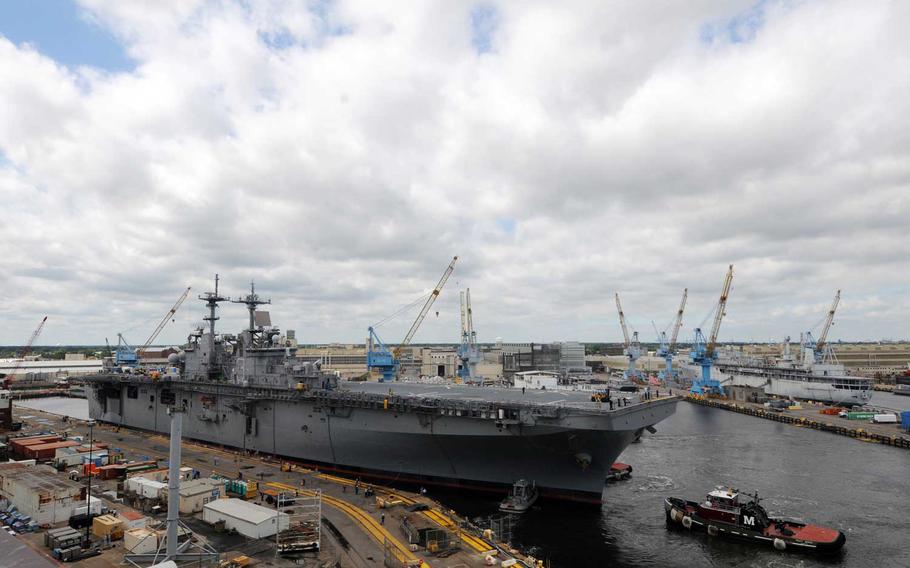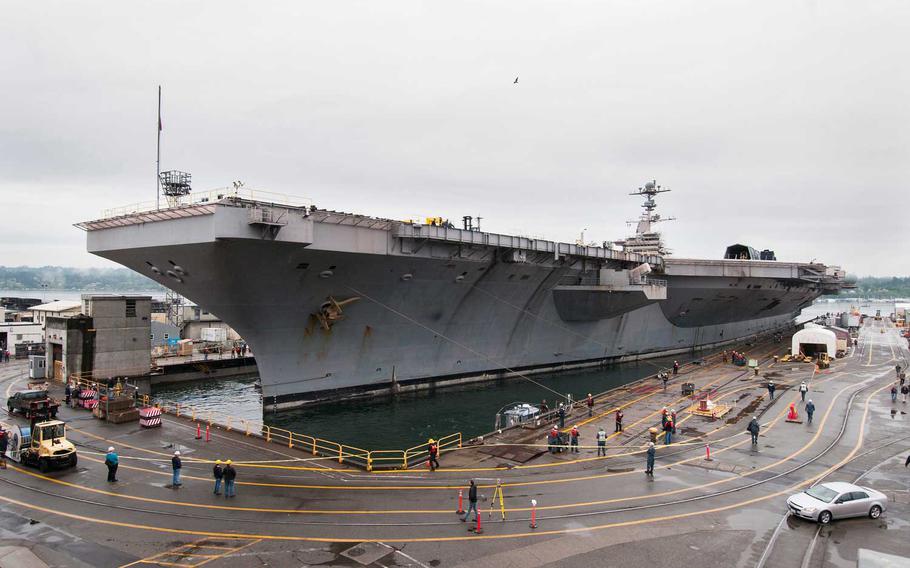
The amphibious assault ship USS Kearsarge is towed out of a Norfolk Naval Shipyard dry dock to a pierside berth. Kearsarge is undergoing a 10-month dry docked planned maintenance availability and is scheduled to go underway this fall. (U.S. Navy)
WASHINGTON — In four years, one ship maintenance center was only able to complete three out of 24 ship repairs on time, despite a new contracting strategy aimed at improving delays, according to a new report.
The Navy’s new method for issuing contracts for ship maintenance called the Multiple Award Contract, Multi-Order approach had some potential benefits compared to the previous strategy such as increased competition and controlling costs through fixed-price deals, according to a 61-page report by the Government Accountability Office.
However, delays in maintenance schedules continue to be a concern.
Navy leadership has said one of the top priorities for the service is to increase the number of its battle force ships from 299 to 355 or more by 2030, but its maintenance backlogs make it difficult to keep on top of the needs of the fleet now.
Senators on the Senate Armed Services Committee in December raised these concerns after another GAO report stated Navy vessels in the past five years have spent an additional, unplanned 33,700 days, or about 90 years, docked at shipyards for maintenance.

The Nimitz-class aircraft carrier USS John C. Stennis (CVN 74) enters dry dock at Puget Sound Naval Shipyard and Intermediate Maintenance Facility to begin a scheduled docking planned incremental availability. The dry dock will provide sailors and shipyard workers access to the ship below the waterline for maintenance, repairs and refurbishments. ( Wendy Hallmark/U.S. Navy)
“My fear is that as the Navy grows, the maintenance capacity will not keep pace, the end result will be a larger fleet, but fewer ships ready for operational tasking,” Sen. David Perdue, R-Ga., chairman of the Senate Armed Services Committee subpanel on seapower, said during the December hearing about maintenance delays.
The GAO report issued last week studied schedules for 41 completed ship repairs between April 2015 to April 2019 at three maintenance centers where the new contract strategy is implemented: the Mid-Atlantic Regional Maintenance Center in Norfolk, Va.; the Southwest Regional Maintenance Center in San Diego, and the Southeast Regional Maintenance Center in Mayport, Fla.
The mid-Atlantic center had the worst performance out of the three centers, only completing three out of 24 ship maintenance availabilities on time during this period. The southeast center completed three out of seven ship availabilities on time and the southwest center completed six out of 10 availabilities on time.
One reason for the increased delays was unplanned work, which requires changes to the contract. The unplanned work refers to “growth work” or issues found during the maintenance period and new work added by the Navy. Changing the contract after it is awarded for the unplanned work using the MAC-MO contract strategy is more difficult and time consuming, according to the report, citing interviews with Navy officials.
One case study cited in the report was for the dock landing ship USS Whidbey Island, which started work August 2017 with a planned completion date for May 2018. Not only was there growth work and new work added to the maintenance period, but the maintenance team had to negotiate more than 800 requests for contract changes with the contractor that caused delays, according to the repot. The work was finally completed December 2019, more than 18 months late.
The GAO report also found the Navy has worked to mitigate the delays caused by the new contract strategy and is using lessons learned from the process. However, there is still issues with obtaining funds to complete maintenance if work is extended into a new fiscal year because it requires the approval of the Navy and the Defense Department, according to the report.
Congress started a pilot program in December to allow the Navy to avoid the approval process, which took between 26 to 189 days, and the GAO recommended the Navy develop an analysis plan for this pilot program.